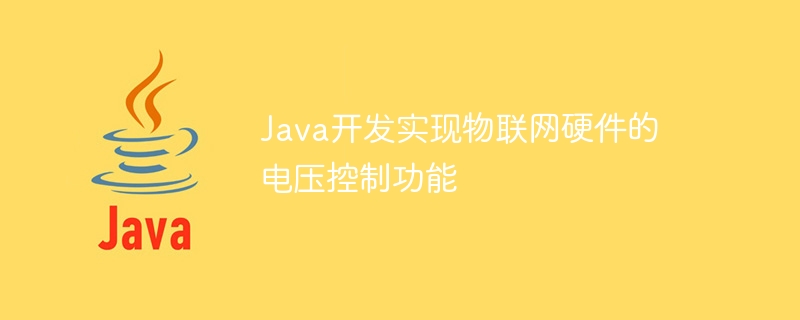

Java development implements the voltage control function of IoT hardware, which requires specific code examples
The Internet of Things (IoT) is a rapidly developing concept that combines the Internet with physics The world is connected, allowing objects to communicate with each other through the Internet. In the Internet of Things, IoT hardware is responsible for collecting and transmitting data, while software is responsible for processing and controlling this data. This article will introduce how to use Java language to develop IoT applications to implement voltage control functions for IoT hardware, and provide specific code examples.
1. Preparation
Before we start writing code, we need to prepare some tools and materials.
2. Write Java code
The following is a simple Java code example for controlling the voltage output of the Arduino development board.
import java.io.BufferedReader;
import java.io.InputStreamReader;
public class VoltageControl {
public static void main(String[] args) {
try {
// 创建一个进程来运行Arduino IDE命令行工具
Process process = Runtime.getRuntime().exec("arduino --upload your_sketch.ino");
// 等待命令执行完成
process.waitFor();
// 获取命令的输出结果
BufferedReader reader = new BufferedReader(new InputStreamReader(process.getInputStream()));
String line;
while ((line = reader.readLine()) != null) {
System.out.println(line);
}
} catch (Exception e) {
e.printStackTrace();
}
}
}In the above code, we use Java’s Runtime class to create a process to run the Arduino IDE’s command line tool. The --upload option is used to upload the code we wrote to the Arduino development board. your_sketch.ino is the name of our Arduino code file.
3. Upload the code to the Arduino development board
Before executing the Java code, we need to upload the Arduino code to the Arduino development board. Below is an example Arduino code for controlling the voltage output of the Arduino board.
int voltagePin = A0; // 电压输入引脚
void setup() {
Serial.begin(9600); // 初始化串口通信
}
void loop() {
int value = analogRead(voltagePin); // 读取电压输入引脚的值
float voltage = value * (5.0 / 1023.0); // 将值转换为电压
Serial.print("Voltage: ");
Serial.print(voltage);
Serial.println(" V");
delay(1000); // 等待1秒钟
} In the above code, we use the analogRead function to read the value of the voltage input pin and convert it into voltage. We then use serial communication to send the results to the computer.
4. Execute Java code
After uploading the Arduino code to the Arduino development board, we can execute the Java code to control the voltage output of the Arduino development board.
In the Java code, we created a process using the Runtime class and ran the command line tool of the Arduino IDE. The command line tool uploads Arduino code to the Arduino development board through the --upload option. After executing the command line tool, we obtain the output result of the command execution through the BufferedReader class and print it to the console.
Through the above steps, we successfully developed and implemented the voltage control function of the Internet of Things hardware using Java. In actual applications, we can adjust and expand the code and hardware accordingly according to needs.
Summary:
This article introduces how to use Java language to develop Internet of Things applications to implement the voltage control function of Internet of Things hardware, and provides relevant code examples. Through the introduction of this article, readers can understand the application of Java in IoT development and start their own IoT projects.
The above is the detailed content of Java develops and implements the voltage control function of IoT hardware. For more information, please follow other related articles on the PHP Chinese website!
 what are prime numbers
what are prime numbers
 How to recover completely deleted files on computer
How to recover completely deleted files on computer
 Introduction to the main work content of the backend
Introduction to the main work content of the backend
 Common encryption methods for data encryption storage
Common encryption methods for data encryption storage
 Can the c drive be expanded?
Can the c drive be expanded?
 Detailed explanation of oracle substr function usage
Detailed explanation of oracle substr function usage
 sublime runs js code
sublime runs js code
 What is digital currency
What is digital currency




